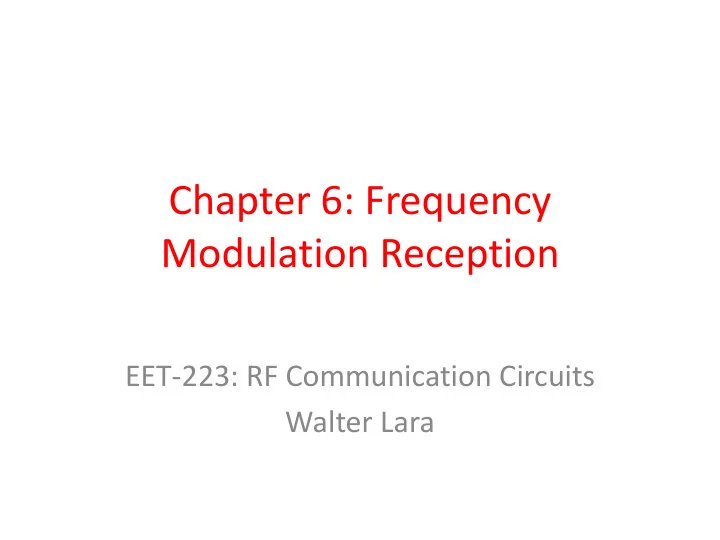

Chapter 6: Frequency Modulation Reception EET-223: RF Communication Circuits Walter Lara
Basic FM Receiver • Refer to Block Diagram at Fig 6-1 • Based on the superhetereodyne principle • Similarities to AM Superheterodyne Receiver: – RF Amplifier: pre-amplifies RF signal (if required) – Local Oscillator (LO): provides steady sine wave – Mixer (aka first detector): mixes RF signal with LO sine wave to produce an RF signal at fixed/known frequency – Intermediate Frequency (IF) Amplifier: provides bulk of RF amplification at fixed frequency (constant BW, avoiding variable-selectivity problem) – Audio/Power Amplifier: amplify as need by speaker
Basic FM Receiver – Cont’d • Differences from AM Superheterodyne Receiver: – AGC not needed on modern receivers with highly stable LO frequency – Addition of Deemphasis Network – Addition of Limiter (more later) – Discriminator instead of Detector (more later)
Figure 6-1 FM receiver block diagram.
Limiters • Outputs a constant amplitude as long as their input amplitude is above certain level (~1V) • When input amplitude is large enough, limiting occurs: – Any variation in amplitude (such as noise) is suppressed – AGC action (for free) because it provides constant input level to Discriminator • Minimum required voltage for limiting is called quieting voltage (aka threshold voltage or limiting knee voltage) • See example circuit at Fig 6-3 & 6-4
Figure 6-3 Transistor limiting circuit.
Figure 6-4 Limiter input/output and flywheel effects.
Discriminators • Extract the intelligence that has been modulated onto the carrier via frequency variations • Provides an intelligence signal whose: – Amplitude is dependent on instantaneous carrier frequency deviation – Frequency is dependent on carrier’s rate of frequency deviation • Desired output amplitude vs input frequency characteristic is shown in Fig 6-5 • Simplest circuit is Slope Detector shown in Fig 6-6
Figure 6-5 FM discriminator characteristic.
Figure 6-6 Slope detection.
Phase-Locked Loop (PLL) Receiver • Refer to block diagram in Fig 6-12 • Phase comparator compares input signal and output of VCO and generates error signal proportional to difference between the two • Error signal drives VCO to change frequency so that the error is reduced to zero • When VCO frequency equals input frequency, the PLL is locked and the control voltage stays constant until PLL input frequency changes again
Phase-Locked Loop (PLL) Receiver – Cont’d • If the PLL input frequency changes, the VCO starts to change frequency until its output is the same frequency as the input • PLL has three states of operation: – Free-running: difference between f vco and f in is too large, PLL cannot adjust to make f vco equal to f in , f vco defaults to a nominal frequency value – Capture: f vco different from f in , but f vco is changing and approaching f in – Locked or tracking: capture has happened, so f vco is equal to f in
Figure 6-12 PLL block diagram.
LM 565 PLL • The LM 565 is an integrated VCO circuit that can be used to build a simple PLL receiver (see Fig 6-13) • Formulas for component parameter calculations are provided by the manufacturer: – Free-Running Frequency: f 0 = 0.3 / (R 0 C 0 ) – Loop Gain: K 0 K D = (33.6 f 0 ) / V C – Hold-In Range (frequency band through which PLL will remain locked): f H = ± (8 f 0 ) / V C
Figure 6-13 An example of an FM receiver using the LM565 PLL.
Stereo Demodulation • Refer to block diagram in Fig 6-15 • FM Stereo receiver are similar to standard (monophonic) up to discriminator output • LPF used to extract L + R signal (30 Hz – 15 KHz) • BPF used to extract L - R double side-band (DSB) signal (23 KHz – 53 KHz) • BPF used to extract 19 KHz subcarrier • AM Demodulator used to demodulate L - R signals • Matrix & Deemphasis Network generates L & R audio signals (see Fig 6-16)
Figure 6-15 Monophonic and stereo receivers.
Figure 6-16 Stereo signal processing.
Recommend
More recommend